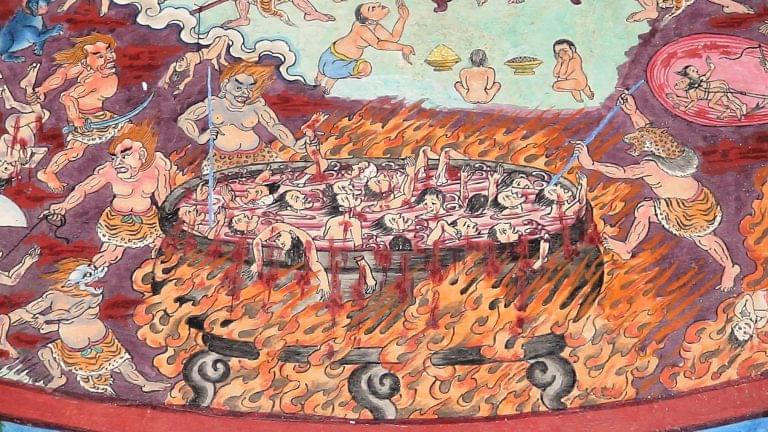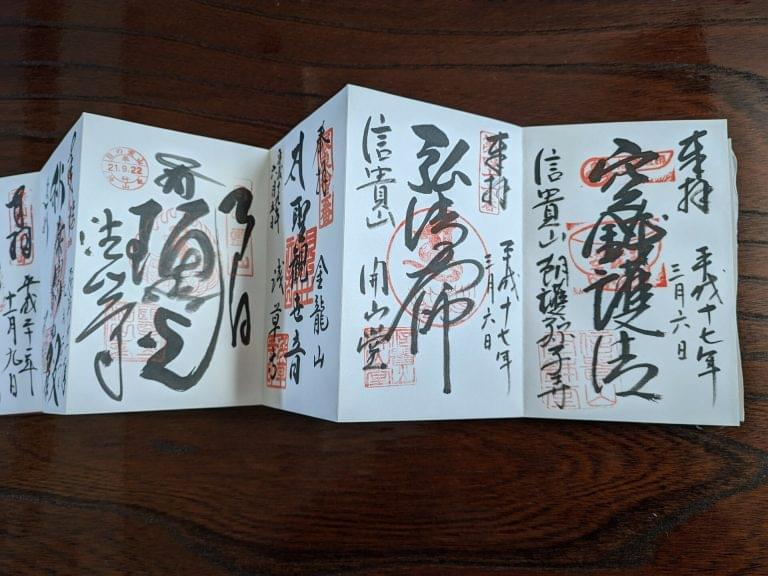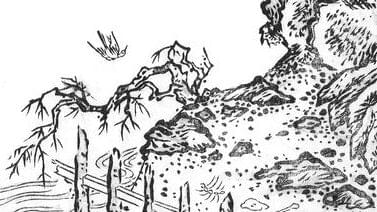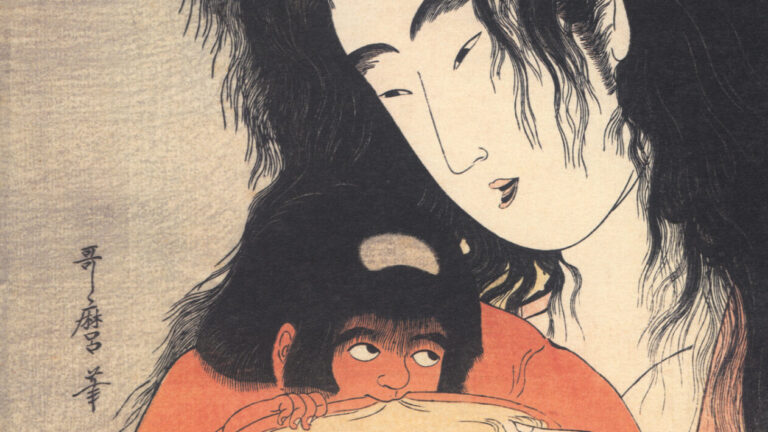Hello there, this is Thersa Matsuura and you’re listening to Uncanny Japan. Here it is, the end of 2023, and I’m feeling that reflective anticipation I think we all get around this time. Looking back at the past year and trying to digest it and make sense of it, but then at the same time I’m feeling excited and hopeful about the coming one. This is the last show of Season 7, and for it I’d like to take you up into the hills to my local temple, where I’ve spent every New Year’s Eve for the past 25 years, or more. This way you too can experience the calming, meditative, and thoroughly spirit-cleansing vibes of joya no kane.
You might have heard me talk about this tradition of ringing out the old year and ringing in the new one, but today I’ll go into more detail about it. So close your eyes and dig these purifying, peaceful temple bell vibes. The ones you hear now were recorded on the binaural microphones this past New Year’s Eve through to New Year’s Day 2023. So don’t worry, they still work. They haven’t lost their magic. But we’ll be going again in a couple days, so I’ll put brand spanking new joya no kane mojo up on Patreon soon. So let’s grab our coats and our hats and walk up that hill.
What Is Joya no Kane?
So let’s start at the beginning. What is joya no kane? Joya refers to New Year’s Eve, or the night preceding the new year. And kané is simply bell. Basically, it’s the Buddhist practice of bonging the temple bell at midnight on New Year’s Eve. I just learned it’s also done in some places in Korea, too. But while in Japan it’s rung 108 times, in Korea it’s only struck 33 times.
Historical Origins of the Bell Ringing Tradition
Before I get into the significance of the number 108, let’s look into the origin of the tradition. During the Kamakura era, late 12th to early 14th centuries, temple bells were rung at dawn and dusk. By the Muromachi era, 14th to the 16th centuries, that grew into a ritual where the bell was rung during the transition from New Year’s Eve to New Year’s Day. It was believed in Zen temples this practice helped to dispel negative energy from entering the kimon, northeast direction, during the change from one year to the next.
I talked about kimon in Episode 11 if you want to know more about that. But basically, it’s the unlucky direction that oni and other bad things can enter and wreak havoc. The point is to start ringing the bell before midnight and keep it going as the old year turns into the new one. If you want to visit a temple that does joya no kane, you should go a little before 12 on New Year’s Eve because that’s when it’ll start. But check to make sure. Because first, not all temples perform joya no kane. And there are some that have begun to change this centuries-old practice, due to complaints from nearby residents of the deep ringing in the middle of the night when they’re trying to sleep, some places have had to suspend the ringing altogether or move it to during the day on New Year’s Eve when everyone’s awake, which kind of makes moot the whole protecting the changing of one year to the next bit.
In 2021, Ryukokuji Temple, in Namekawa City, shifted the time of bell ringing to 2:30 p.m. They had good reason, though. Due to an aging population, fewer people were making the midnight trek to the temple, and those who did had a difficult time because the stone steps would get slippery with ice. Moving to an earlier time was to make it easier for temple-goers to participate in the ritual.
Why 108 Rings? The Mathematical Explanation
Now, on to why 108 rings. Well, there are actually various theories. But the one you’ll hear the most, and the one I always believed, is that it symbolizes ringing out humankind’s sins or earthly desires. What does that mean? I actually found the math.
See if you can follow me. Each of the six senses—sight, hearing, smell, taste, touch, and mind—has three aspects. Pleasant, unpleasant, and neutral, resulting in 18 categories. Each of these 18 categories can be further classified as pure or impure. That totals 36. These 36 categories are then assigned to past, present, and future lives, resulting in a total of 108, symbolizing the human earthly desires.
Alternative Theories About the Number 108
There are other theories. Some think the bell is rung because if you add the four-fold miseries, 36, with the eight-fold anxieties, 72, combined, you’ll arrive at 108. And finally, there’s the thinking that the number represents a year. This one, too, is quite esoteric, but it goes something like this. By adding the number of months, 12, to solar systems, 24, to micro-seasons, 72, the number is 108, thus symbolizing a full year. Voila!
Remember, though, that some temples don’t even count. Think how crappy you’d feel, standing in line only to be person number 109. And then you’re told, sorry, no lucky ring for you. Scoot along home now. Happy New Year.
So, yeah, not counting is also a thing. Unless, of course, only the monks at the temple bell are ringing, then they’ll do exactly 108. That happens a lot, too, especially in larger temples. People gather to be there for joya no kane, but the ringing and the sutra, or prayer reciting, is done solely by the monks.
How Radio Popularized Joya no Kane
So how did a Buddhist tradition become so popular all over Japan? Why, radio, of course. The first live radio broadcast of joya no kane took place at Kaneiji Temple in Ueno, Tokyo, in 1927. And this really helped to popularize the tradition.
World War II and the Metal Collection Law
That is, until World War II. That’s when, in 1941, the metal collection law came into effect, and many temple bells, as well as ordinary people’s pots, pans, pieces of copper, and old nails, were confiscated for metal recycling to be melted down to make weapons and other useful war of things. Bells might have been taken, but that didn’t stop the New Year spirit. People would bang on taiko drums instead.
Experiencing Joya no Kane Today
You can listen and watch the bell ringing online if you’d like. It looks like some of the bigger temples will have live streams on YouTube. One that is particularly cool is Chionji in Kyoto. Here, the bell is enormous, and it takes a whole team of monks all pulling rhythmically on ropes to ring it. The main monk literally gets parallel to the ground, holding himself up by the rope and using his entire body weight to bring the giant wooden beam knocker thing to hit the bell. It’s pretty intense.
These days, still, joya no kane is seen as a purification ceremony, too. The sound of the bell as it washes over and through you, symbolically washes away all that bad mojo, so that you can start the new year afresh. It also represents new beginnings and promises hope for the future.
A New Year’s Blessing
Speaking of hope, I hope that by listening to this episode about joya no kane, you are able to find a little peace and some hope, but also have all your transgressions from 2023 carried away with the sonorous ringing of the bell. If you’re like me, that might take a while. So I’ll tell you what. I’ll let the bell ring for a minute or two longer just to make sure we take care of all those pesky sins. Don’t want to forget any.
And I want to give you all a thank you from the bottom of my heart for listening to the show and being a part of this strange little journey we’re all on together. Those who support the show on Patreon, because of you, I’ve been able to spend more time working on it and writing. From late 2022 to early 2023, I was able to write five stories, three of which were published this year. The Child of the Gods, Buddha Bone, and Zipperback, all found homes. I was also able to say yes when asked to write another 12-part serialized story for the Asahi newspaper. That’s coming up starting January. And I also had time to write The Book of Japanese Folklore, and work with David Dastmalchian on his upcoming comic, Knights vs. Samurai. So thank you so, so much. I have more big dreams for 2024 that I want to share with you and make you proud. You’re all the absolute best. So here’s some extra bongs for purification, good luck, and hope for you in the new year. Everyone, yoi otoshi wo.






